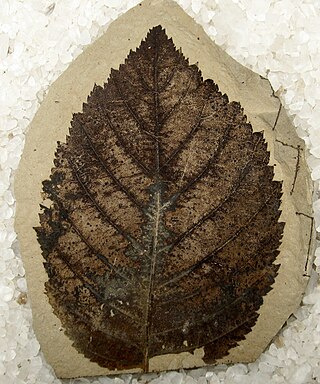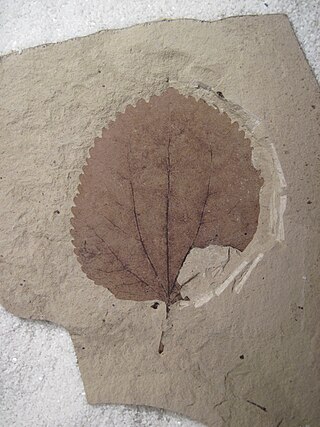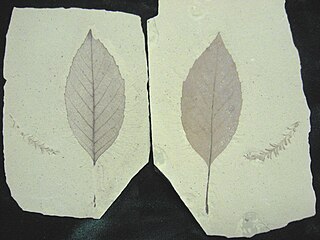
Florissantia is an extinct genus of flowering plants in the Malvaceae subfamily Sterculioideae known from western North America and far eastern Asia. Flower, fruit, and pollen compression fossils have been found in formations ranging between the Early Eocene through to the Early Oligocene periods. The type species is Florissantia speirii and three additional species are known, Florissantia ashwillii, Florissantia quilchenensis, and Florissantia sikhote-alinensis.

Tilia johnsoni is an extinct species of flowering plant in the family Malvaceae that, as a member of the genus Tilia, is related to modern lindens. The species is known from fossil leaves found in the early Eocene deposits of northern Washington state, United States and a similar aged formation in British Columbia, Canada.

Dinokanaga is a small genus of scorpionfly belonging to the extinct family Dinopanorpidae. The six species D. andersoni, D. dowsonae, D. hillsi, D. sternbergi, D. webbi, and D. wilsoni have all been recovered from Eocene fossil sites in British Columbia, Canada, and Washington state, United States.

Ginkgo dissecta is an extinct ginkgo species in the family Ginkgoaceae described from a series of isolated fossil leaves. The species is known from Early Eocene sediments exposed in the province of British Columbia, Canada, and Washington, USA. It is one of two Ginkgo species found at the Washington and British Columbia sites.

The Princeton Chert is a fossil locality in British Columbia, Canada, which comprises an anatomically preserved flora of Eocene Epoch age, with rich species abundance and diversity. It is located in exposures of the Allenby Formation on the east bank of the Similkameen River, 8.5 km (5.3 mi) south of the town of Princeton, British Columbia.

The Allenby formation is a sedimentary rock formation in British Columbia which was deposited during the Ypresian stage of the Early Eocene. It consists of conglomerates, sandstones with interbedded shales and coal. The shales contain an abundance of insect, fish and plant fossils known from 1877 and onward, while the Princeton Chert was first indented in the 1950's and is known from anatomically preserved plants.

Langeria is an extinct genus of flowering plants in the family Platanaceae containing the solitary species Langeria magnifica. Langeria is known from fossil leaves found in the early Eocene deposits of northern Washington state, United States and similar aged formations in British Columbia, Canada.
Cuspilongus is an extinct genus of symphytan wasps in the sawfly family Cephidae and the only genus in the subfamily Cuspilonginae. At the time of its description, the genus comprised a single species, Cuspilongus cachecreekensis. A second species, Cuspilongus ghilarovi, was transferred from Mesocephus, which it had been ascribed to at the time of description in 1988. The genus is known from fossils found in the Early Cretaceous of Mongolia and Early Eocene of Canada.

Tsukada is an extinct genus of flowering plant in the family Nyssaceae related to the modern "dove-tree", Davidia involucrata, containing the single species Tsukada davidiifolia. The genus is known from fossil leaves found in the early Eocene deposits of northern Washington state, United States and a similar aged formation in British Columbia, Canada.

Ulmus okanaganensis is an extinct species of flowering plant in the family Ulmaceae related to the modern elms. The species is known from fossil leaves, flowers, and fruits found in the early Eocene deposits of northern Washington state, United States and similar aged formations in British Columbia, Canada.

Betula leopoldae is an extinct species of birch in the family Betulaceae. The species is known from fossil leaves, catkins, and inflorescences found in the early Eocene deposits of northern Washington state, United States, and similar aged formations in British Columbia, Canada. The species is placed as basal in Betula, either as a stem group species, or an early divergent species.

Tetracentron hopkinsii is an extinct species of flowering plant in the family Trochodendraceae. The species is known from fossil leaves found in the early Eocene deposits of northern Washington state, United States and south Central British Columbia. The species was first described from fossil leaves found in the Allenby Formation. T. hopkinsii are possibly the leaves belonging to the extinct trochodendraceous fruits Pentacentron sternhartae.
Paraconcavistylon is an extinct genus of flowering plant in the family Trochodendraceae comprises a single species, Paraconcavistylon wehrii. The genus is known from fossil fruits and leaves found in the early Eocene deposits of northern Washington state, United States, and southern British Columbia, Canada. The species was initially described as a member of the related extinct genus Concavistylon as "Concavistylon" wehrii, but subsequently moved to the new genus Paraconcavistylon in 2020 after additional study.

Comptonia columbiana is an extinct species of sweet fern in the flowering plant family Myricaceae. The species is known from fossil leaves found in the early Eocene deposits of central to southern British Columbia, Canada, plus northern Washington state, United States, and, tentatively, the late Eocene of Southern Idaho and Earliest Oligocene of Oregon, United States.
Acer spitzi is an extinct maple species in the family Sapindaceae described from a single fossil samara. The species is solely known from the Early Eocene sediments exposed in northeast Washington state, United States. It is the only species belonging to the extinct section Spitza.
The paleoflora of the Eocene Okanagan Highlands includes all plant and fungi fossils preserved in the Eocene Okanagan Highlands Lagerstätten. The highlands are a series of Early Eocene geological formations which span an 1,000 km (620 mi) transect of British Columbia, Canada and Washington state, United States and are known for the diverse and detailed plant fossils which represent an upland temperate ecosystem immediately after the Paleocene-Eocene thermal maximum, and before the increased cooling of the middle and late Eocene to Oligocene. The fossiliferous deposits of the region were noted as early as 1873, with small amounts of systematic work happening in the 1880-90s on British Columbian sites, and 1920-30s for Washington sites. A returned focus and more detailed descriptive work on the Okanagan Highlands sites revived in the 1970's. The noted richness of agricultural plant families in Republic and Princeton floras resulted in the term "Eocene orchards" being used for the paleofloras.

Ulmus chuchuanus is an extinct species of flowering plant in the family Ulmaceae related to the modern elms. The species is known from fossil leaves and fruits found in early Eocene sites of northern Washington state, United States and central British Columbia, Canada.

Alnus parvifolia is an extinct species of flowering plant in the family Betulaceae related to the modern birches. The species is known from fossil leaves and possible fruits found in early Eocene sites of northern Washington state, United States, and central British Columbia, Canada.
The Paleobiota of the Klondike Mountain Formation comprises a diverse suite of Early Eocene plants and animals recovered from North Central Washington State. The formation outcrops in locations across the north western area of Ferry County, with major sites in Republic, north west of Curlew Lake, and on the Toroda Creek area. The formation is the southern most of the Eocene Okanagan Highlands, sharing much of the paleoflora and paleofauna with site across Central and southern British Columbia.















